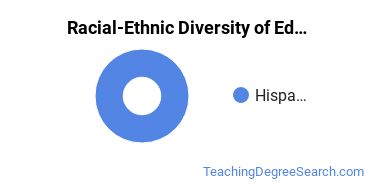Bachelor’s Degrees in Education/Teaching of Individuals with Orthopedic & Other Physical Health Impairments
Education Levels of Education/Teaching of Individuals with Orthopedic and Other Physical Health Impairments Majors
During the most recent year for which data is available, 34 people earned their bachelor's degree in education/teaching of individuals with orthopedic and other physical health impairments. This makes it the 52nd most popular bachelor's degree program in the country.
The following table shows the number of diplomas awarded in education/teaching of individuals with orthopedic and other physical health impairments at each degree level.
| Education Level | Number of Grads |
|---|---|
| Bachelor’s Degree | 34 |
| Graduate Certificate | 3 |
Earnings of Education/Teaching of Individuals with Orthopedic and Other Physical Health Impairments Majors With Bachelor’s Degrees
At this time, we do not have the data to estimate the median earnings for this class of people.
Student Debt
We do not have the data to estimate the median debt for this class of people.
Student Diversity
More women than men pursue their bachelor's degree in education/teaching of individuals with orthopedic and other physical health impairments. About 64.7% of graduates with this degree are female.
| Gender | Number of Grads |
|---|---|
| Men | 12 |
| Women | 22 |

The racial-ethnic distribution of education/teaching of individuals with orthopedic and other physical health impairments bachelor’s degree students is as follows:
| Race/Ethnicity | Number of Grads |
|---|---|
| Asian | 0 |
| Black or African American | 0 |
| Hispanic or Latino | 33 |
| White | 1 |
| International Students | 0 |
| Other Races/Ethnicities | 0 |

Most Popular Education/Teaching of Individuals with Orthopedic and Other Physical Health Impairments Programs for Bachelor’s Degrees
There are 3 colleges that offer a bachelor’s degree in education/teaching of individuals with orthopedic and other physical health impairments. Learn more about the most popular 3 below:
The most popular school in the United States for education/teaching of individuals with orthopedic and other physical health impairments students seekinga bachelor's degree is University of Puerto Rico - Bayamon. Each year, around 3,500 students seeking various degrees attend the university. During the most recent year for which we have data, 44 people received their bachelor's degree in education/teaching of individuals with orthopedic and other physical health impairments from UPR Bayamon. About 64% of this group were women, and 100% were students from an underrepresented racial-ethnic group.
Eastern Michigan University is the 2nd most popular school in the nation for students seeking a bachelor's degree in education/teaching of individuals with orthopedic and other physical health impairments. The average in-state tuition for full-time undergraduates is $15,200 per year, while in-state graduate students, on average, pay $17,231 per year. During the most recent year for which we have data, 0 people received their bachelor's degree in education/teaching of individuals with orthopedic and other physical health impairments from Eastern Michigan.
Explore Major by State
Alabama
Arkansas
Connecticut
Florida
Idaho
Iowa
Louisiana
Massachusetts
Mississippi
Nebraska
New Jersey
North Carolina
Oklahoma
Rhode Island
Tennessee
Vermont
West Virginia
Related Majors
Below are some popular majors that are similar to education/teaching of individuals with orthopedic and other physical health impairments that offer bachelor’s degrees.
| Major | Annual Degrees Awarded |
|---|---|
| General Special Education | 6,415 |
| Early Childhood Special Education | 986 |
| Elementary Special Education | 602 |
| Other Special Education & Teaching | 358 |
| Teaching for Learning Disabilities | 173 |
References
*The racial-ethnic minority student count is calculated by taking the total number of students and subtracting white students, international students, and students whose race/ethnicity was unknown. This number is then divided by the total number of students at the school to obtain the percentage of racial-ethnic minorities.
- College Factual
- National Center for Education Statistics
- O*NET Online
- Bureau of Labor Statistics
- Image Credit: By woodleywonderworks under License
More about our data sources and methodologies.


